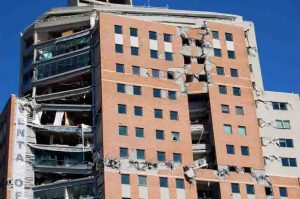
Earthquakes and explosions damage thousands of structures worldwide each year, destroying countless lives in their wake, but a team of researchers at Penn State is examining a completely new way of safeguarding key infrastructure, thanks to a $50,000 Multidisciplinary Research Seed Grant provided by the College of Engineering.
“The goal of the project is to protect critical structures,” said Cliff Lissenden, professor of engineering science and mechanics. “The structural design for earthquakes now requires the whole building to shake, which you can design for, but it’s quite an expensive proposition. Our idea is that if you can dissipate the earthquake before it gets to the structure, then you don’t have to design it to resist that ground motion.”
Parisa Shokouhi, principal investigator on the project and associate professor of civil engineering, and Lissenden will use a mixture of numerical and experimental study to evaluate the effectiveness of a proposed metamaterial in filtering, dissipating and averting surface waves caused by natural and man-made sources.
“What we are developing right now is a very simple model,” said Shokouhi. “We are considering a plate with rods that would act as local resonators, and we are looking into what combination and what geometry of rods will dissipate the incoming energy that is traveling through the plane.”
The first step to their project, a numerical study, will focus on finding the ideal size and arrangement of holes and their core elements. The researchers will do that by performing 2D and 3D finite element modeling and simulations. The model parameters will be systematically changed until they can obtain the most desired arrangement.
Based on the outcome of the numerical study, the researchers will then build and test a small-scale simplified model using the recommended formation. They will test a small aluminum plate with punched holes and steel rods to simulate the resonating units. A shaker or stack of piezo elements mounted on the plate will serve as the stimulus. The wave field across the plate will then be recorded.
Then, the team will replicate a scaled-down version of a life-size scenario using a soil-filled box on a shake table. The holes will be drilled in the compacted soil and the steel or wooden rods will be inserted. This will allow the team to study the effects of soil heterogeneity, non-elastic and nonlinear behavior, and water saturation on the performance of the metamaterial.
If the results are favorable, this research could lead to a fundamental change in the way engineers design structures to combat the damaging effects of earthquakes and explosions.
“I think there is a lot of potential, but we are trying to investigate the phenomenon from the bottom up to really understand what’s going on,” said Shokouhi. “We want to know exactly how these resonators stop these waves, so that we can design them effectively.”
Established in 2014, the Multidisciplinary Research Seed Grant program aims to help faculty attract high-impact multidisciplinary and center-level research funding from the state and federal government, industry or foundations. This one-year project will conclude in January 2018.
Note: The above post is reprinted from materials provided by Penn State College of Engineering.










